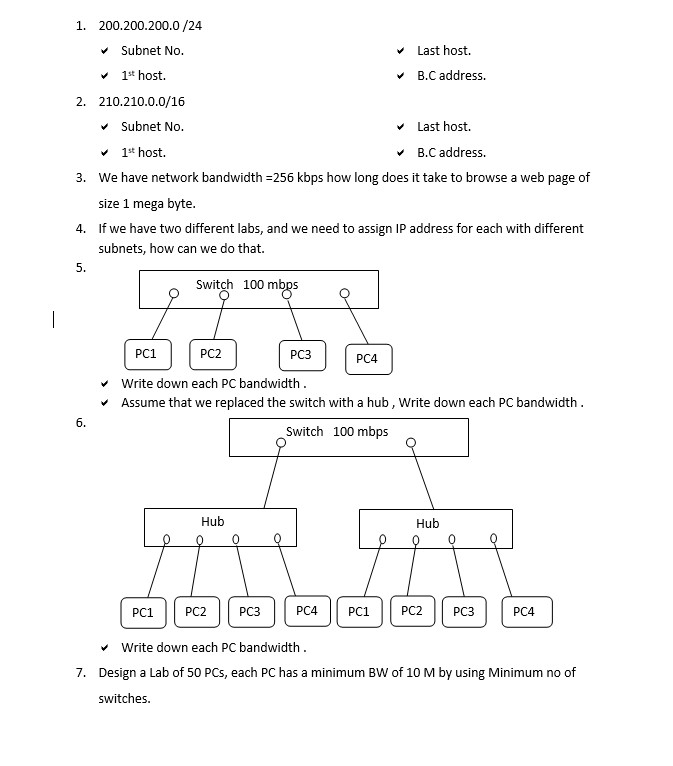1. For the address 200.200.200.0 /24, determine the Subnet No., Last host, First host, and B.C address. 2. For the address 210.210.0.0 /16, determine the Subnet No., Last host, Fir... 1. For the address 200.200.200.0 /24, determine the Subnet No., Last host, First host, and B.C address. 2. For the address 210.210.0.0 /16, determine the Subnet No., Last host, First host, and B.C address. 3. Given a network bandwidth of 256 kbps, how long does it take to browse a web page of size 1 megabyte? 4. If we have two different labs and need to assign IP addresses for each with different subnets, how can we do that? 5. Write down each PC bandwidth for a switch with 100 Mbps connecting PCs PC1 to PC4. 6. Assume we replaced the switch with a hub; write down each PC bandwidth. 7. Design a lab for 50 PCs, each with a minimum bandwidth of 10 Mbps, using the minimum number of switches.

Understand the Problem
The question involves subnetting, determining network bandwidth, and IP address assignment for different labs. It asks for specific calculations related to network parameters and configurations, including designs for a laboratory setup.
Answer
1. 200.200.200.0/24: Subnet 200.0, First host 200.1, Last host 200.254, B.C. 200.255. 2. 210.210.0.0/16: Subnet 210.0.0, F. host 210.0.1, L. host 210.255.254, B.C. 210.255.255. 3. 32 seconds. 4. Use different /24s for labs. 5. Switch: 100 Mbps/PC. Hub: 25 Mbps/PC. 7. Use 5 switches.
- 200.200.200.0 /24: Subnet No. 200.200.200.0, First host 200.200.200.1, Last host 200.200.200.254, B.C. address 200.200.200.255.
- 210.210.0.0 /16: Subnet No. 210.210.0.0, First host 210.210.0.1, Last host 210.210.255.254, B.C. address 210.210.255.255.
- It takes approximately 32 seconds to browse a webpage of size 1 MB.
- Assign separate subnets from a larger block (e.g., use 192.168.1.0/24 for lab 1 and 192.168.2.0/24 for lab 2).
- With a switch, each PC has 100 Mbps. With a hub, the bandwidth is shared, so each PC effectively has 25 Mbps.
- Each PC would effectively have 25 Mbps.
- Use 5 switches with 12 ports each to ensure a minimum bandwidth of 10 Mbps per PC.
Answer for screen readers
- 200.200.200.0 /24: Subnet No. 200.200.200.0, First host 200.200.200.1, Last host 200.200.200.254, B.C. address 200.200.200.255.
- 210.210.0.0 /16: Subnet No. 210.210.0.0, First host 210.210.0.1, Last host 210.210.255.254, B.C. address 210.210.255.255.
- It takes approximately 32 seconds to browse a webpage of size 1 MB.
- Assign separate subnets from a larger block (e.g., use 192.168.1.0/24 for lab 1 and 192.168.2.0/24 for lab 2).
- With a switch, each PC has 100 Mbps. With a hub, the bandwidth is shared, so each PC effectively has 25 Mbps.
- Each PC would effectively have 25 Mbps.
- Use 5 switches with 12 ports each to ensure a minimum bandwidth of 10 Mbps per PC.
More Information
The key to solving subnetting problems is understanding how to determine host and network portions of an address. Bandwidth calculations involve converting between units (kilobits to megabytes). Hubs share bandwidth, while switches provide dedicated bandwidth.
Tips
Ensure accuracy by double-checking bit values in IP addresses and subnet masks. When dealing with bandwidth, always convert units properly.
Sources
- How to calculate a subnet mask from hosts and subnets | TechTarget - techtarget.com
- IP Subnet Calculator - calculator.net
AI-generated content may contain errors. Please verify critical information